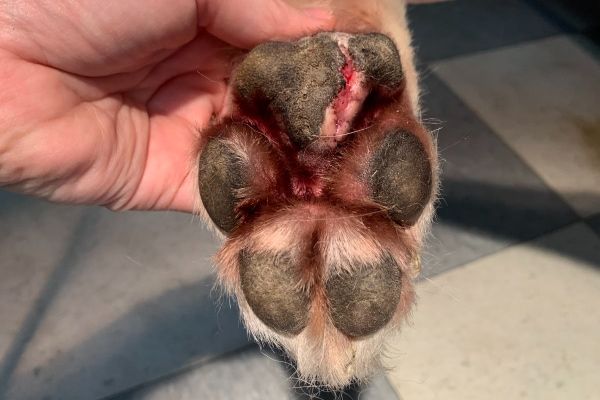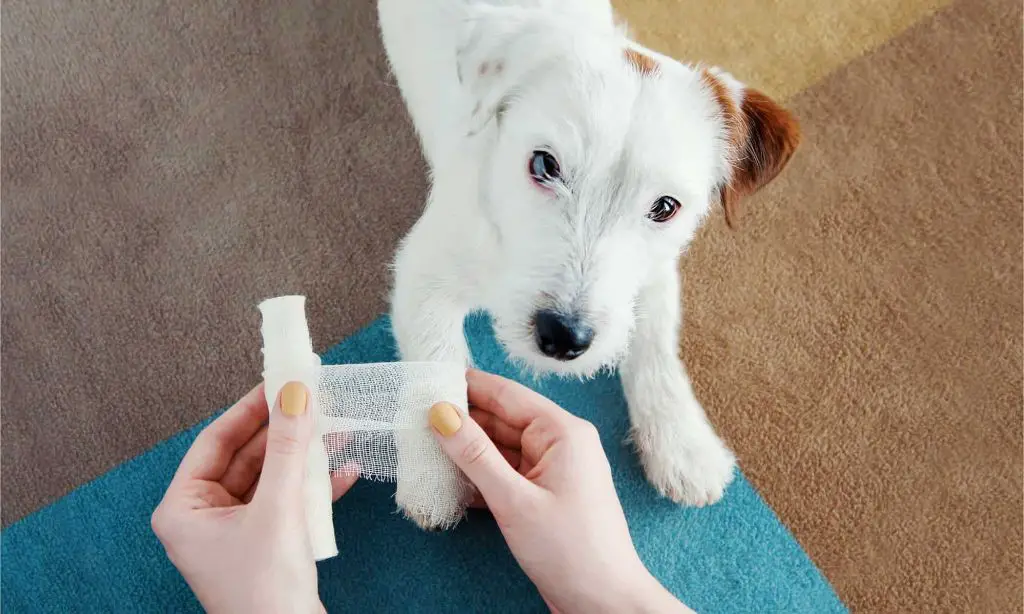What Causes Dogs to Lick Wounds
Dogs lick wounds for several reasons that originate from natural canine behaviors and instincts:
Instinctual grooming behavior – Dogs instinctively lick themselves as a way of grooming and cleaning. When they have an injury or wound, their innate response is to lick the area in an attempt to clean it and promote healing. Licking is a self-soothing, comforting action for dogs when they are hurt.
Curiosity/investigation – Dogs explore the world through smelling and licking. When they notice a new wound or injury, they will be curious about it and want to investigate it closely. Licking allows them to explore the wound and gather more information about it. It’s a natural investigative behavior.

Seeking attention – Licking can also be a way for dogs to solicit attention from their human caregivers. If they receive attention when they lick a wound, they may continue licking to get more attention. The behavior can become reinforced.
Potential Risks of Licking
Allowing a dog to lick an open wound poses some risks that pet owners should consider. One of the biggest concerns is infection from bacteria in the dog’s saliva. As noted by the AKC, “A dog’s mouth and nose harbor bacteria that could cause infection in people” (source). While a dog’s saliva does contain compounds that can help inhibit bacterial growth, there are still many potentially harmful bacteria present.
Some specific bacteria found in dog saliva that can delay wound healing and cause infections in humans include Pasteurella, Capnocytophaga, and streptococci. According to PetMD, “If these bacteria are introduced into the body via an open wound, they can multiply rapidly and cause infections” (source). Wound infections caused by bacteria from dog saliva often require antibiotic treatment.
Another concern is that excessive licking and chewing can irritate the wound and surrounding skin. This irritation can lead to inflammation, hot spots, and potential self-mutilation behaviors in the dog. The constant agitation from licking can also slow down proper healing. That’s why it’s usually recommended to discourage dogs from licking wounds whenever possible.
When to Allow Licking
It’s generally okay to allow your dog to lick minor cuts or abrasions. A dog’s saliva contains substances that can help clean superficial wounds by removing debris and dirt. Licking helps stimulate blood flow and promotes healing as well.

Allowing licking can also provide comfort to your dog. The soothing motions of their tongue can help relieve pain and distress. This is due in part to the natural anesthetics in saliva that numb nerve endings.
However, according to PetMD, you should limit licking of minor wounds to just the first few licks. Prolonged licking can delay healing and introduce infection. The occasional lick can help clean, but compulsive licking should be discouraged.
When to Discourage Licking
While a dog’s saliva contains compounds that can help heal minor wounds, licking should be discouraged for large, deep wounds, following surgery, or on broken skin. As the AKC notes, “Licking and chewing can also slow healing by reopening wounds. Surgery sites are especially dangerous for dogs to lick. Licking can break down sutures and interfere with the healing process.”
Vets caution that licking can introduce bacteria into a wound, increasing the risk of infection. Licking can also cause further trauma to the wound site and delay healing. Preventing licking allows the wound to close and heal properly.
According to PetMD, signs that licking is interfering with healing include: “redness, swelling, discharge, a bad odor, and a change in color.” If these signs are present, steps should be taken to prevent further licking right away.
First Aid for Wounds
The first steps for caring for an open wound on a dog are to clean, disinfect, and cover the injured area. Here are some tips for providing first aid:
Clean the wound with a saline solution to flush away debris. Saline can be made by mixing warm water with a teaspoon of salt. Be sure to use clean water that has been boiled and cooled. Gently pat dry with a clean towel.
Apply a mild, non-stinging antiseptic such as a 2% chlorhexidine solution. This will help prevent infection. Do not use hydrogen peroxide since this can damage healthy tissue.
Cover the wound with a sterile bandage or gauze. Wrap loosely enough to allow for swelling. Change the bandage frequently to keep the area clean.
Over-the-counter antibiotic ointments can also be applied after cleaning to promote healing. However, be sure to check with your veterinarian, as some pets may be allergic to certain ingredients.
Following proper first aid steps can greatly improve wound recovery. However, always consult a veterinarian for any deep, large, or heavily contaminated wounds which may require medical treatment.
Seeing the Veterinarian

There are certain situations when you should take your dog to see the veterinarian for care of a wound rather than attempting to treat it yourself at home. Signs that it is time to seek professional veterinary care include:
Signs of infection – This includes redness, swelling, discharge, foul odor, and heat coming from the wound site. Infections can spread quickly and be dangerous if left untreated, so it is important to have your vet assess the wound.
Persistent licking – If your dog continues to excessively lick at the wound despite your efforts to deter this behavior, a vet visit is a good idea. The vet can assess if there is an underlying issue causing the persistent licking.
Deep puncture wounds – While you can often manage small superficial wounds at home, deep puncture wounds require professional cleaning and treatment. The deeper tissue can easily become infected, so your vet should evaluate and care for these wounds.
Other situations that warrant a vet visit include wounds that are bleeding profusely, wounds that won’t close properly, wounds on the face/head, wounds that show signs of tissue trauma or orthopedic injury, wounds sustained from an unknown cause, wounds sustained more than 6-12 hours ago, and any wound you are uncertain how to properly manage at home. It’s always a good idea to consult your vet if you have concerns about a dog’s wound.
Preventing Licking
There are several methods you can try to prevent your dog from licking its wound. One of the most common and effective is using an Elizabethan collar, often referred to as an “e-collar.” The plastic cone goes around your dog’s neck and prevents it from being able to reach the wound with its tongue (1). Though it may seem uncomfortable at first, most dogs get used to wearing an e-collar quickly. Be sure to properly fit and secure the collar so your dog can’t work its way out of it.
Another technique is to try distracting your dog whenever it goes to lick, such as with a toy or treat. Redirecting their attention can help break the habit. You can also try bitter tasting sprays designed to deter licking, such as Grannick’s Bitter Apple. Spray it around the wound area and it will make the skin taste awful to your dog (2). However, some dogs still persist in licking despite the bad taste. These sprays work best in combination with an e-collar until the wound has healed.
Keeping the wound covered with a bandage is another option, but only if your dog won’t chew or scratch at it. Ensure you frequently change the bandage to keep the area clean. Alternatively, you can have your vet apply a protective wound sealant that prevents licking.
With patience and consistency, you can prevent your dog from excessively licking most wounds. But if its obsessive licking behavior persists despite your efforts, consult your veterinarian, as anxiety or a medical issue could be a factor.
(2) https://www.licksleeve.com/blogs/news/tips-on-how-you-can-keep-your-dog-from-licking-its-wound
Underlying Causes
There are several potential underlying causes that may prompt a dog to excessively lick wounds and sores:
Allergies – Dogs may develop skin allergies or irritations from food, environmental factors, shampoos, or other topical products. These allergies cause itchiness, inflammation, and discomfort that lead to excessive licking, chewing, and biting at the skin. Controlling allergies through diet change or medications can reduce wound licking.
Parasites – Parasites like fleas, ticks, and mange mites can infest a dog’s skin and cause severe itching and skin irritation. Dogs will lick, scratch and bite at the skin in an effort to relieve discomfort caused by parasites. Treating the parasitic infection will eliminate this trigger for wound licking.
Anxiety/stress – Stress, boredom, loneliness and separation anxiety can prompt obsessive licking behaviors in dogs. Licking provides comfort and distraction from emotional distress. Addressing sources of anxiety through training, increased exercise and mental stimulation can minimize obsessive licking habits.
When to Be Concerned
While it’s natural for dogs to lick wounds, excessive licking can be problematic. According to the AKC, constant licking and chewing can lead to irritation, infections, and even self-mutilation https://www.akc.org/expert-advice/health/should-dogs-lick-wounds/. PetMD also warns that wound licking can damage surrounding tissues and delay healing https://www.petmd.com/dog/general-health/how-keep-your-dog-licking-their-wounds.
Signs of excessive licking to watch for include bleeding, swelling, or changes to the wound. You should also note any changes in your dog’s behavior, such as increased aggressiveness or irritability, which could indicate pain or discomfort from the wound. Excessive licking that leads to noticeable inflammation or changes in behavior warrants a veterinary visit for proper treatment.
Providing Proper Care
Properly caring for an open wound is crucial for healing. Here are some tips for providing the right care:
Monitor the wound closely, at least twice per day. Check for signs of infection like pus, foul odor, swelling, or redness spreading from the wound. If you notice any of these, contact your veterinarian (Dog Wound Care: A Complete Guide).

Keep the wound clean by gently flushing with warm water or a pet-safe antiseptic solution recommended by your vet. Clean the wound at least twice daily. Use gauze pads to pat dry (Care of Open Wounds in Dogs | VCA Animal Hospitals).
Give any medications prescribed by your vet, like antibiotics or pain relievers, exactly as directed. Complete the full course even if the wound looks better.
Proper at-home care in between veterinary visits can promote healing and prevent complications. Monitor closely and follow your vet’s recommendations.